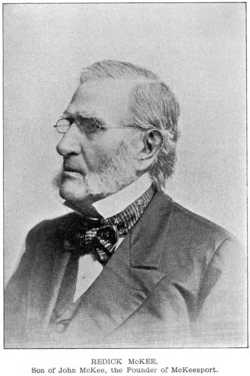Redick McKee facts for kids
Redick McKee (born December 7, 1800 – died September 13, 1886) was an important American government official. He is best known for his work as a United States Indian Agent in California during the 1850s. In this role, he helped create treaties with Native American tribes.
Contents
Redick McKee: A Life of Service
Early Years and Education
Redick McKee was born in McKeesport, Pennsylvania, a town his father founded. When Redick was five years old, his father passed away. In 1807, his family moved to Pittsburgh. For the next ten years, McKee worked on a relative's farm and for merchants in Pittsburgh.
At 18, he joined the Presbyterian Church. This was a very important moment for him. He later wrote that he felt like he was "living in a new world." He wanted to serve what he called a "loving and compassionate Master." McKee had the chance to become a priest and study at Canonsburg, Pennsylvania and Princeton University, but he chose not to.
Still at 18, McKee was hired to manage a general store and a storage place in Wheeling, West Virginia. In November 1818, he started the first Sabbath school in Wheeling. This school welcomed students from different Protestant churches. Sometimes, more than 80 students attended the school.
Working as an Indian Agent
In 1850, the United States government created a special group of three men. Their job was to write treaties with the Native American tribes in California. Redick McKee was one of these three men. The other two were O. M. Wozencraft and George W. Barbour. They started their talks in 1851.
However, these men did not know much about California Native Americans. They also didn't understand how these groups used their lands. So, the commissioners decided to divide California into three areas. Each man largely worked on his own. McKee was given the job of making treaties with tribes in Northern California.
Making Treaties in California
McKee and his group arrived at the Upper Klamath River in September 1851. At that time, there was a lot of fighting and revenge attacks happening in Northern California. Local American groups were said to be very violent. They were "revenging outrages" that they claimed Native Americans had committed.
McKee and his team visited the lands of the Shasta people. They looked closely at the Shasta and Scott valleys. They decided that only the Scott Valley could be used for a reservation. A reservation is a special area of land set aside for Native American tribes. This land would also need to support farming to feed the Shasta people. This was because there wasn't much good farming land in the Klamath Mountains. There were better areas nearby, but they were in Oregon.
The Shasta people wanted to keep all of Scott Valley for their reservation. But American settlers from Scott Bar, California and Yreka, California also wanted the valley. Government officials talked with these settlers to find out what they wanted in a treaty with the Shasta. The settlers wanted all Shasta people to move to a reservation at the start of the Shasta River.
The treaty terms that McKee wrote were not very popular with either the Shasta or the American settlers. The reservation was placed in Scott Valley, but most of the valley stayed with the settlers. McKee estimated that the reservation area in the treaty had about four or five square miles of land good for farming. Most American settlers in the area seemed to accept the location of the Shasta reservation, even if they weren't completely happy about it.
Why the Treaties Failed
McKee, Barbour, and Wozencraft negotiated a total of 18 treaties. McKee pushed hard for the California government to accept these treaties. He argued that the reservations were designed to let Native Americans keep parts of their traditional lands. At the same time, these treaties would keep open the many areas where gold was found.
McKee said that the commissioners always talked with local American settlers and miners. They did this when setting the borders of each reservation. He also argued that if no one could "propose a more humane and available system," then the California government had to accept the reservations. However, the state of California rejected all the treaties. It also told its representatives in Washington, D.C., to work against them.
President Millard Fillmore, the Commissioner of Indian Affairs Luke Lea, and the new superintendent of Indian affairs for California Edward Fitzgerald Beale supported the treaties. The treaties were sent to the Committee on Indian Affairs in June 1852. After a private meeting, the treaties were rejected.
Some people believe that the huge amount of land set aside by the treaties made them unpopular in Congress. Also, the large amount of money the commissioners planned to spend made the agreements unpopular. In total, the 18 reservations would have covered about 11,700 square miles. This is about 7% of all the land in California.
Later Life
Redick McKee passed away at his son's home in Washington, D.C. on September 13, 1886.


